Wireless Connectivity Chipset Market Size
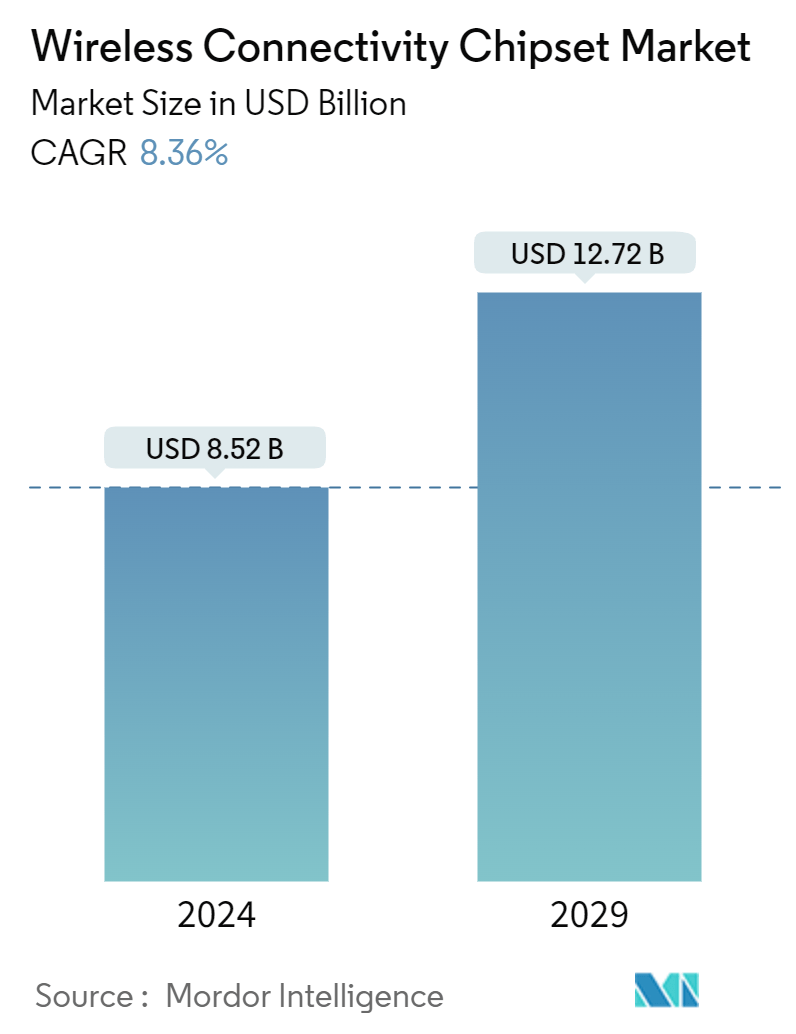
| Study Period | 2019 - 2029 |
| Market Size (2024) | USD 8.52 Billion |
| Market Size (2029) | USD 12.72 Billion |
| CAGR (2024 - 2029) | 8.36 % |
| Fastest Growing Market | Asia-Pacific |
| Largest Market | Asia-Pacific |
Major Players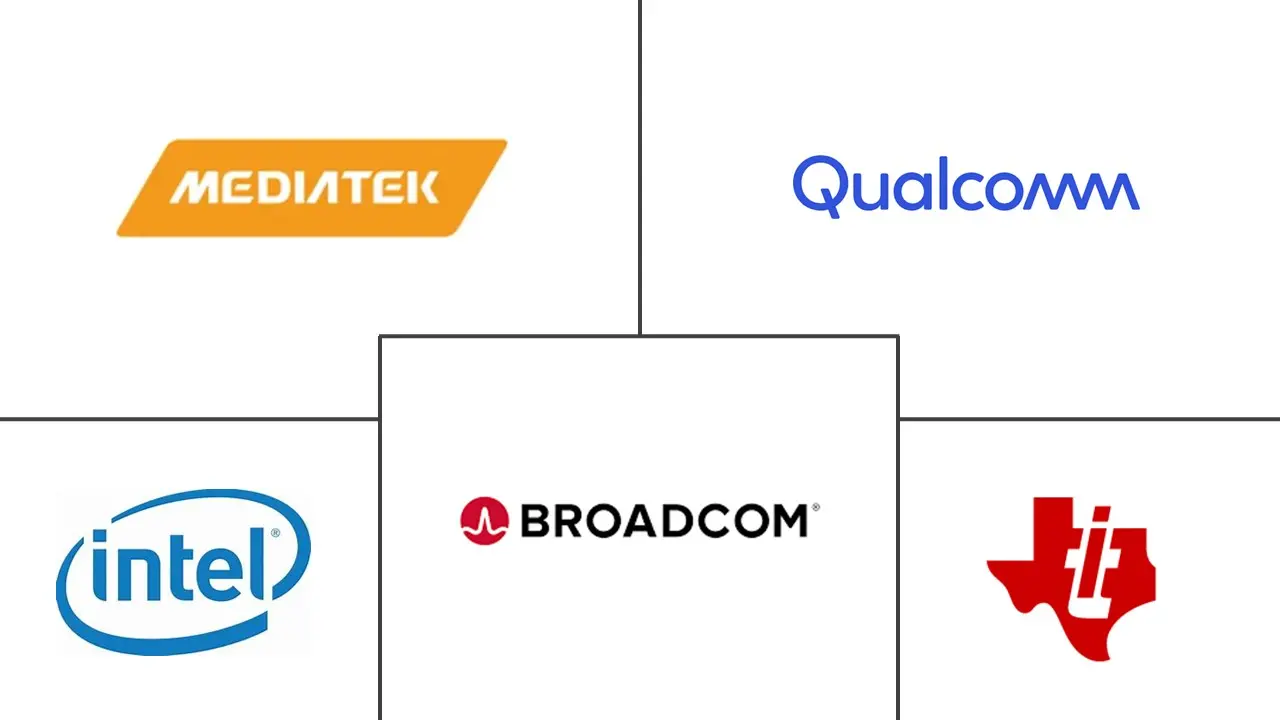
*Disclaimer: Major Players sorted in no particular order |
Wireless Connectivity Chipset Market Analysis
The Wireless Connectivity Chipset Market size is estimated at USD 8.52 billion in 2024, and is expected to reach USD 12.72 billion by 2029, growing at a CAGR of 8.36% during the forecast period (2024-2029).
- With the growing penetration of high-speed internet, the adoption of connected devices and smart home applications is increasing, especially in regions such as Europe, North America, and Asia-Pacific. Some major solutions include voice assistants, smart thermostats, smart lighting, security cameras, and smart appliances.
- Further, in May 2024, MediaTek announced the debut of two new chipsets with powerful performance and support for the latest AI enhancements across multiple verticals. These included the Kompanio 838 SoC for premium Chromebooks and the Pentonic 800 SoC for 4K premium smart TVs and displays. The company highlighted major developments in product categories such as AI, automotive, IoT, TVs, Chromebooks, and wireless connectivity.
- For instance, the IMT-2030 (6G) Promotion Group was formed in China to speed up the R&D of 6G technology. Around 2030, the world is anticipated to witness the commercialization of 6G. China is leading the charge in supporting the commercialization of 5G, which will provide a solid basis for developing 6G.
- Adding several devices, such as in IoT, increases the surface area of a network, creating more potential attack vectors in the process. Even a single unsecured device connected to a network may serve as a point of entry for an active attack on the network.
- According to the Organisation for Economic Co-operation and Development survey, by 2025, the number of households with computers is anticipated to increase to 1,262.47 million. Homes with at least one computer are referred to as computer households. Such a massive boost in computer adoption will create an opportunity for the market players to expand their Wi-Fi chipset product portfolio, expand their presence in different regions, and advance their market share.
- Various players in the market are developing new products to stay competitive, which may further propel market growth. For instance, in November 2023, MediaTek, an early pioneer in Wi-Fi 7 technology, solidified its position as a market leader with the launch of its latest offerings, the Filogic 860 and Filogic 360. These additions significantly expanded MediaTek's cutting-edge product line, emphasizing the latest connectivity technologies for superior performance and unwavering reliability.
- The Filogic 860 chipsets, featuring a dual-band access point and an advanced network processor, are tailored for enterprise access points, service provider gateways, mesh nodes, and various retail and IoT router applications. On the other hand, the Filogic 360 facilitates Wi-Fi 7 2x2 capabilities and dual Bluetooth 5.4 radios in a single chip. This design is specifically crafted to bring next-gen Wi-Fi 7 connectivity to edge and streaming devices, as well as a wide range of consumer electronics.
- High costs associated with developing and producing advanced Wi-Fi chipsets pose a significant challenge in the market. The sophisticated and expensive technology needed for manufacturing these chipsets inflates the final product's cost, potentially hindering adoption, especially among price-sensitive consumers.
- Post-COVID-19, there was a shift to opting for digital modes for relevant meetings and discussions while focusing more on adopting collaborative tools. Furthermore, emerging use cases for 5G, including the need to support increasing numbers of individuals schooling and working from home, are expected to drive 5G investment. In addition, many workplaces have adopted a hybrid model of working, for which 5G connections can be deployed for better connectivity. Such cases have positively driven the market despite the disruptions caused due to shortages in the supply chain.
Wireless Connectivity Chipset Market Trends
Wi-Fi Standalone Holds the Maximum Share of the Market
- The evolution of Wi-Fi network technology allows users to experience faster speeds and lower latency. It boosted the use of data-heavy services and applications. The significant rise in the volume of data carried by Wi-Fi networks has been primarily driven by customer demand for video and business and consumer moves to cloud services. This factor is expected to drive the need for a wireless 5G connection with fast and high-capacity networks.
- Internet penetration has scaled up in the modern world. According to the International Telecommunication Union, as of 2023, the estimated number of internet users worldwide was 5.4 billion, up from 5.1 billion in the previous year. This share represented 67% of the global population.
- According to a report from Snapchat, by 2025, around 75% of the global population and almost all smartphone users will be frequent AR technology users, out of which more than 1.5 billion are anticipated to be millennials. According to GSMA's Mobile Economy China, China will add around 340 million smartphone connections by 2025, with adoption rising to 9 in 10 connections, 1.5 billion in Mainland China, 12.3 million in Hong Kong, 1.9 million in Macao, and 25.7 million in Taiwan.
- In February 2024, Stage X, a South Korean company, announced that it was awarded a spectrum that will enable it to be the nation's fourth mobile carrier and planned to launch nationwide mobile network services in the first half of 2025. The company invested USD 462 million (KRW 612.8 billion) to deploy its 28 GHz 5G network across South Korea with a plan to build 6,000 base stations; it also involved the mandated installation standard for the 28 GHz frequency network.
- According to Ericsson's Mobility Report, the monthly average usage of mobile data in North America is expected to reach 49 GB per month for smartphones in 2026. A smartphone-savvy consumer base, video-rich applications, and large data plans will drive traffic growth. While there may be robust growth in traffic per smartphone in the near term, the adoption of immersive consumer 5G connections utilizing AR and VR is expected to lead to an even better growth rate in the long term.
- Lower latency is also poised to enable high-speed virtual and augmented reality video without glitches or delays. Mobile connectivity can be strengthened with small cell infrastructure, densifying 5G wireless signals and improving their movement through concrete buildings and walls. Small-cell antennas will also enhance wireless connection, supporting more devices on the same network simultaneously. Such developments are expected to drive the market.
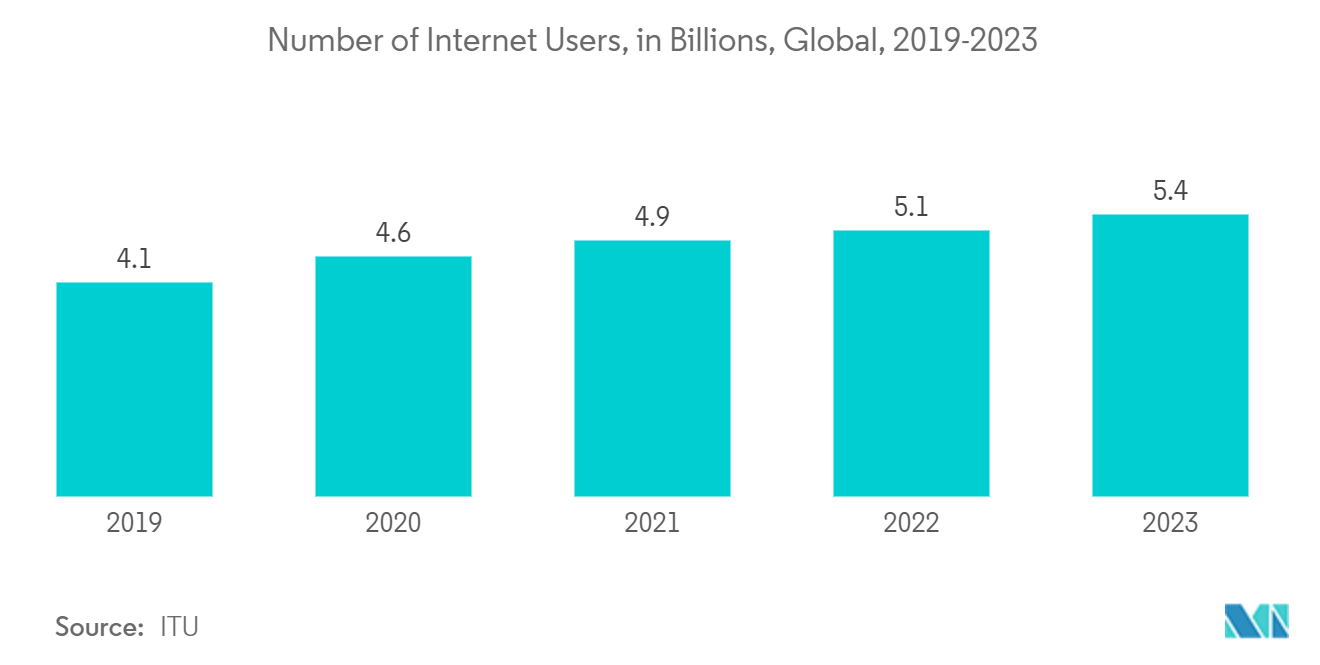
Asia-Pacific is Expected to be the Fastest-growing Market
- The advent of 5G in the Asia-Pacific region accelerated wireless connectivity chipset deployment for high-speed network connectivity. Japan's government granted permission to install 5G base stations on 208,000 traffic lights across the country. Local administrations and operators shared the costs of using the traffic lights for 5G deployments. This will help with more solution deployment in less time, thereby circulating 5G connectivity faster throughout the country.
- Various Indian multinational educational technology companies, such as Byju's, provide their students with a tablet as a part of their educational curriculum to educate the students via digital methods along with the traditional methods of teaching. Such initiatives by the companies in the market are expected to promote further the demand for tablets, smartphones, and other consumer electronics in the market, thereby driving the market for wireless connectivity chipsets for tablets in the region during the forecast period.
- The increasing demand for internet services in the Asia-Pacific region is also expected to promote the adoption of wireless connectivity chipsets in the region. As per the prime minister of India, the launch of 5G internet services in India is expected to bring new economic possibilities and societal benefits to the nation.
- In addition, China is leading 5G development on a worldwide scale. More than 2.54 million 5G base stations have been built nationwide, and more than 575 million people now own 5G smartphones. The country further plans to invest CNY 1.2 trillion (USD 174.2 billion) in 5G network construction by 2025. This growing demand for a 5G stable network is accelerating the deployment of small-cell solutions in the country.
- Due to the increasing availability and affordability of 5G smartphones and the rapid adoption of smartphones in metropolitan and rural areas, 5G subscriptions are expected to rapidly increase to reach approximately 50 million in the region by the end of 2023.
- In February 2023, Network operators M1 and StarHub in Singapore formed an alliance named Antina. They extended their contract with Nokia to improve indoor and outdoor 5G coverage nationwide. To provide a better 5G user experience with high bandwidth, breakneck speeds, and minimal latency, Nokia will install its small cell solution called airscale indoor radio (ASiR), covering new buildings with multiple input, multiple outputs (MIMO) adaptive antennas.
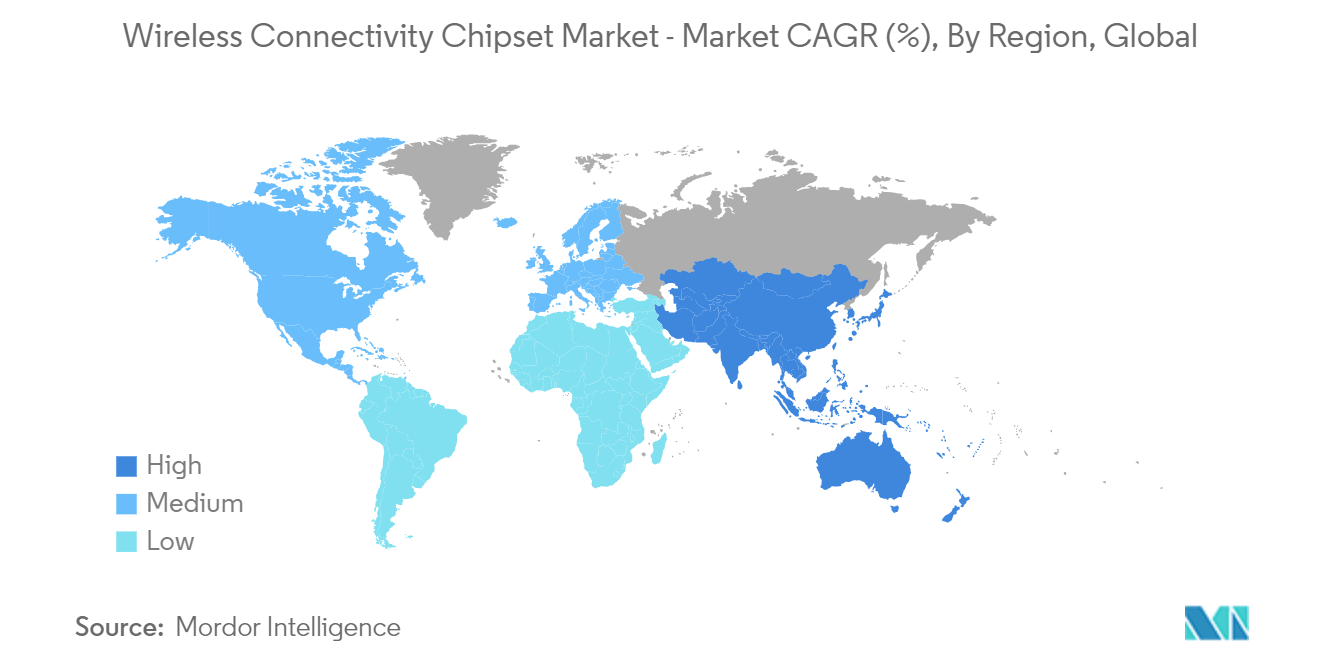
Wireless Connectivity Chipset Industry Overview
The wireless connectivity chipset market is fragmented, with many players like Broadcom Inc., Qualcomm Incorporated, Mediatek Inc., Intel Corporation, and Texas Instruments Incorporated. The companies are also increasing their market presence by introducing new products, expanding their operations, and entering strategic mergers, partnerships, and acquisitions.
- June 2023: Broadcom unveiled its second-generation Wi-Fi 7 chipsets: the BCM6765 residential Wi-Fi 7 access point chip, the BCM47722 enterprise Wi-Fi 7 access point chip with dual IoT radios that support operation for Bluetooth Low Energy (BLE), Zigbee, Thread, and Matter protocols, and the BCM4390 low-power Wi-Fi 7, Bluetooth, and 802.15.4 combo chip designed for use in mobile devices. BCM47722 enterprise Wi-Fi 7 access point SoC specifications allow wireless connectivity.
- April 2023: Texas Instruments unveiled its latest SimpleLink family, a line of Wi-Fi 6 companion integrated circuits (ICs). These ICs are designed to empower designers to create robust, secure, and efficient Wi-Fi connections, particularly for applications in high-density or high-temperature settings, reaching up to 105 °C. The initial offerings from TI's CC33xx family cater to both Wi-Fi 6 and Bluetooth Low Energy 5.3, all within a single IC.
Wireless Connectivity Chipset Market Leaders
-
Broadcom Inc.
-
Qualcomm Incorporated
-
Intel Corporation
-
Texas Instruments Incorporated
-
MediaTek Inc.
*Disclaimer: Major Players sorted in no particular order
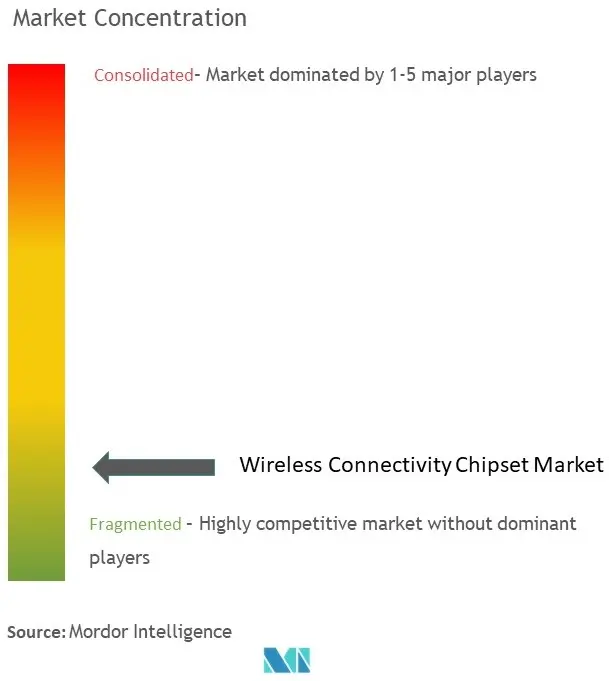
Wireless Connectivity Chipset Market News
- April 2024: Ceva Inc., a licensor of silicon and software IP players, unveiled its latest offering, Ceva-Waves™ Links™. This new family of multi-protocol wireless platform IPs is designed to empower Smart Edge devices, enhancing their ability to connect, sense, and process data with heightened reliability and efficiency. The suite of integrated IPs not only complies with the most recent wireless standards but also caters to the escalating demand for connectivity-rich chips. These chips are specifically tailored for Smart Edge devices across diverse sectors, including consumer IoT, industrial applications, automotive, and personal computing. The standout feature of these IPs is their comprehensive support for a spectrum of wireless protocols, encompassing Wi-Fi, Bluetooth, Ultra-Wideband (UWB), and IEEE 802.15.4 (for Thread/Zigbee/Matter).
- March 2024: Murata, a leading electronics manufacturer, announced a collaboration with Infineon to develop a new IoT development solution. This comprehensive solution will facilitate Murata's Infineon-based Wi-Fi® and Bluetooth® modules' seamless integration with a wide range of STM32 Nucleo-144 boards to help reduce the time-to-market for many wireless-enabled applications. By leveraging each other's capabilities, it is engineered to provide hardware and software solutions that address several IoT development requirements. For its core competencies, the platform solution allows the STM32 microcontroller to connect Murata M.2 wireless modules featuring Infineon chipsets.
Wireless Connectivity Chipset Market Report - Table of Contents
1. INTRODUCTION
- 1.1 Study Assumptions and Market Definition
- 1.2 Scope of the Study
2. RESEARCH METHODOLOGY
3. EXECUTIVE SUMMARY
4. MARKET INSIGHTS
- 4.1 Market Overview
-
4.2 Industry Attractiveness - Porter's Five Forces Analysis
- 4.2.1 Bargaining Power of Suppliers
- 4.2.2 Bargaining Power of Buyers
- 4.2.3 Threat of New Entrants
- 4.2.4 Threat of Substitutes
- 4.2.5 Degree of Competition
- 4.3 Assessment of the Impact of Macroeconomic Trends on the Market
5. MARKET DYNAMICS
-
5.1 Market Drivers
- 5.1.1 Increased Demand for Connected Homes Through Home Automation
- 5.1.2 Increasing Internet Penetration into Homes and Enterprises
-
5.2 Market Challenges
- 5.2.1 Issues Related to Security and Privacy of Data and Connectivity of Devices and Interoperability
- 5.2.2 Slow Demand for Some Mobile Handset Types
6. MARKET SEGMENTATION
-
6.1 By Type
- 6.1.1 Wi-Fi Standalone
- 6.1.2 Bluetooth Standalone
- 6.1.3 Wifi and Bluetooth Combo
- 6.1.4 Low-power Wireless IC
-
6.2 By End-user Application
- 6.2.1 Consumer
- 6.2.2 Enterprise
- 6.2.3 Mobile Handsets
- 6.2.4 Automotive
- 6.2.5 Industrial
- 6.2.6 Other End-user Applications
-
6.3 By Geography***
- 6.3.1 North America
- 6.3.2 Europe
- 6.3.3 Asia
- 6.3.4 Australia and New Zealand
- 6.3.5 Latin America
- 6.3.6 Middle East and Africa
7. COMPETITIVE LANDSCAPE
-
7.1 Company Profiles*
- 7.1.1 Broadcom Inc.
- 7.1.2 Qualcomm Incorporated
- 7.1.3 Mediatek Inc.
- 7.1.4 Intel Corporation
- 7.1.5 Texas Instruments Incorporated
- 7.1.6 STMicroelectronics NV
- 7.1.7 NXP Semiconductors NV
- 7.1.8 On Semiconductor Corporation
- 7.1.9 Infineon Technologies AG
- 7.1.10 Microchip Technology Inc.
- 7.1.11 Qorvo Inc.
- 7.1.12 Skyworks Solutions Inc.
- 7.1.13 Hisilicon Technologies Co. Ltd
- 7.1.14 Tsinghua Unigroup Co. Ltd (unisoc (Shanghai) Technologies Co. Ltd
8. VENDOR MARKET SHARE ANALYSIS
9. INVESTMENT ANALYSIS
10. FUTURE OF THE MARKET
** Subject To AvailablityWireless Connectivity Chipset Industry Segmentation
A wireless chipset is designed to be a part of the internal hardware of wireless communication procedures to allow computers or systems to communicate with each other through wireless means, such as Wi-Fi, Bluetooth, or a combination of both.
The wireless connectivity chipset market is segmented by type (Wi-Fi standalone, Bluetooth standalone, Wi-Fi & Bluetooth combo, and low-power wireless IC), end-user applications (consumer, enterprise, mobile handsets, automotive, industrial, and other end-user applications), and geography (North America, Europe, Asia-Pacific, and the Rest of the World). The market sizes are provided in terms of value (USD) for all the above segments.
| By Type | Wi-Fi Standalone |
| Bluetooth Standalone | |
| Wifi and Bluetooth Combo | |
| Low-power Wireless IC | |
| By End-user Application | Consumer |
| Enterprise | |
| Mobile Handsets | |
| Automotive | |
| Industrial | |
| Other End-user Applications | |
| By Geography*** | North America |
| Europe | |
| Asia | |
| Australia and New Zealand | |
| Latin America | |
| Middle East and Africa |
Wireless Connectivity Chipset Market Research FAQs
How big is the Wireless Connectivity Chipset Market?
The Wireless Connectivity Chipset Market size is expected to reach USD 8.52 billion in 2024 and grow at a CAGR of 8.36% to reach USD 12.72 billion by 2029.
What is the current Wireless Connectivity Chipset Market size?
In 2024, the Wireless Connectivity Chipset Market size is expected to reach USD 8.52 billion.
Who are the key players in Wireless Connectivity Chipset Market?
Broadcom Inc., Qualcomm Incorporated, Intel Corporation, Texas Instruments Incorporated and MediaTek Inc. are the major companies operating in the Wireless Connectivity Chipset Market.
Which is the fastest growing region in Wireless Connectivity Chipset Market?
Asia-Pacific is estimated to grow at the highest CAGR over the forecast period (2024-2029).
Which region has the biggest share in Wireless Connectivity Chipset Market?
In 2024, the Asia-Pacific accounts for the largest market share in Wireless Connectivity Chipset Market.
What years does this Wireless Connectivity Chipset Market cover, and what was the market size in 2023?
In 2023, the Wireless Connectivity Chipset Market size was estimated at USD 7.81 billion. The report covers the Wireless Connectivity Chipset Market historical market size for years: 2019, 2020, 2021, 2022 and 2023. The report also forecasts the Wireless Connectivity Chipset Market size for years: 2024, 2025, 2026, 2027, 2028 and 2029.
Wireless Connectivity Chipset Industry Report
Statistics for the 2024 Wireless Connectivity Chipset market share, size and revenue growth rate, created by Mordor Intelligence™ Industry Reports. Wireless Connectivity Chipset analysis includes a market forecast outlook 2029 and historical overview. Get a sample of this industry analysis as a free report PDF download.



